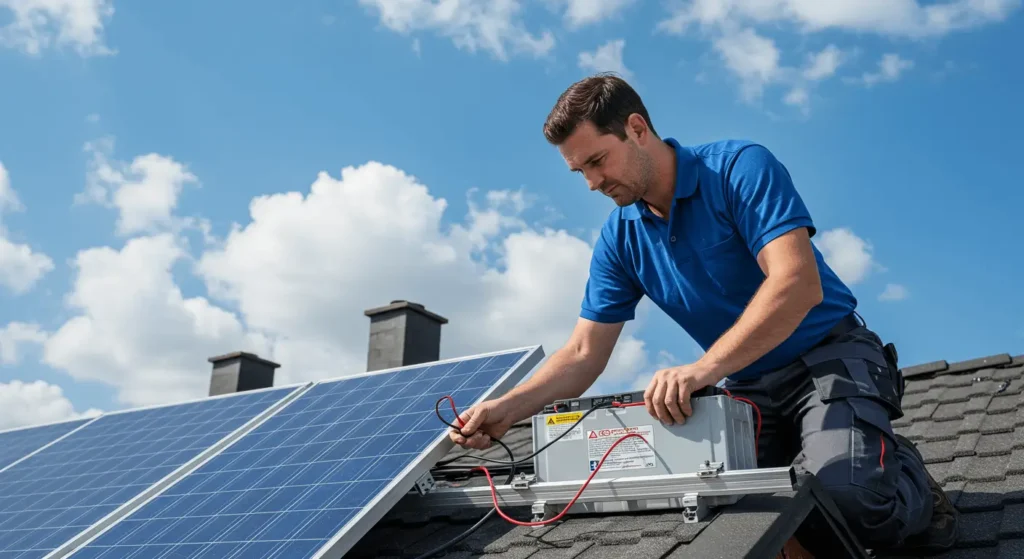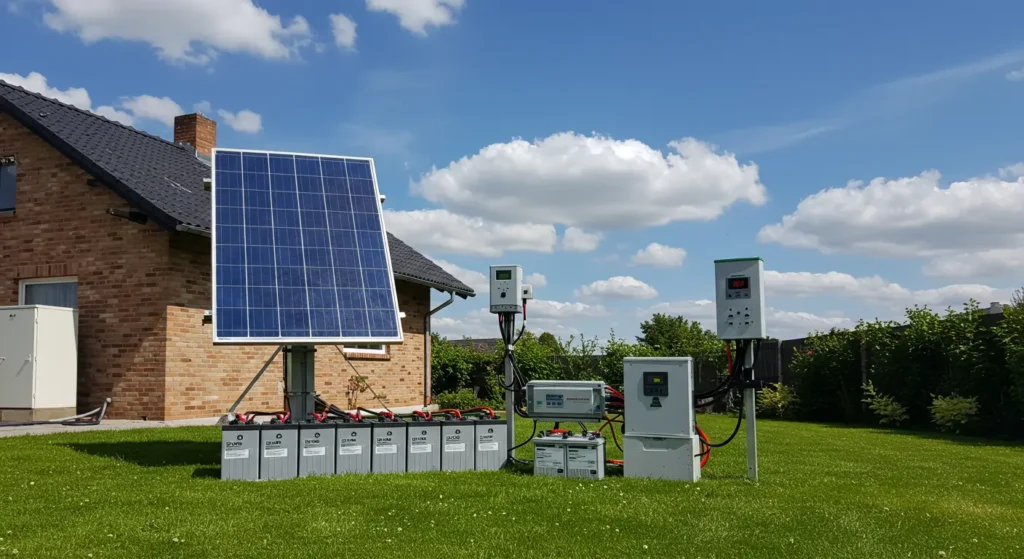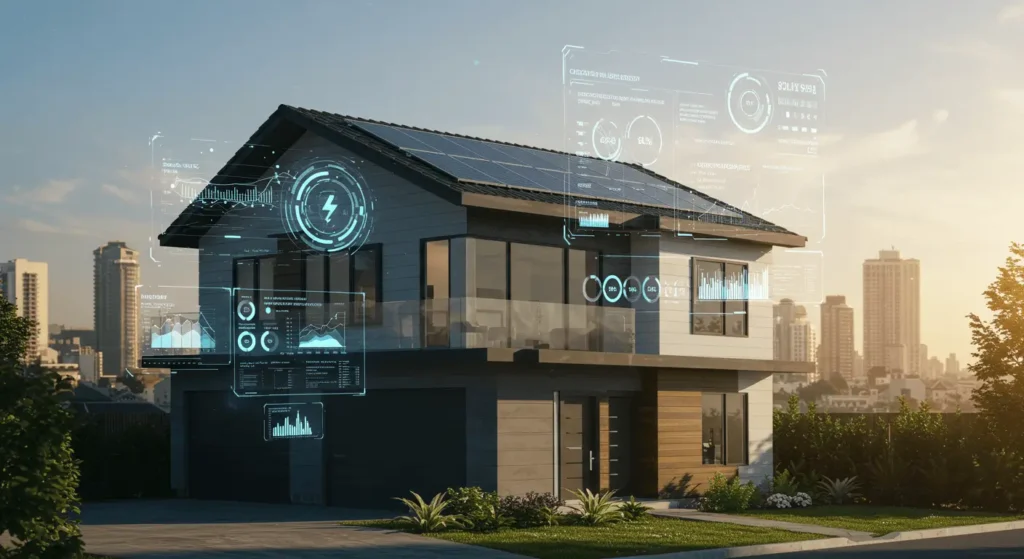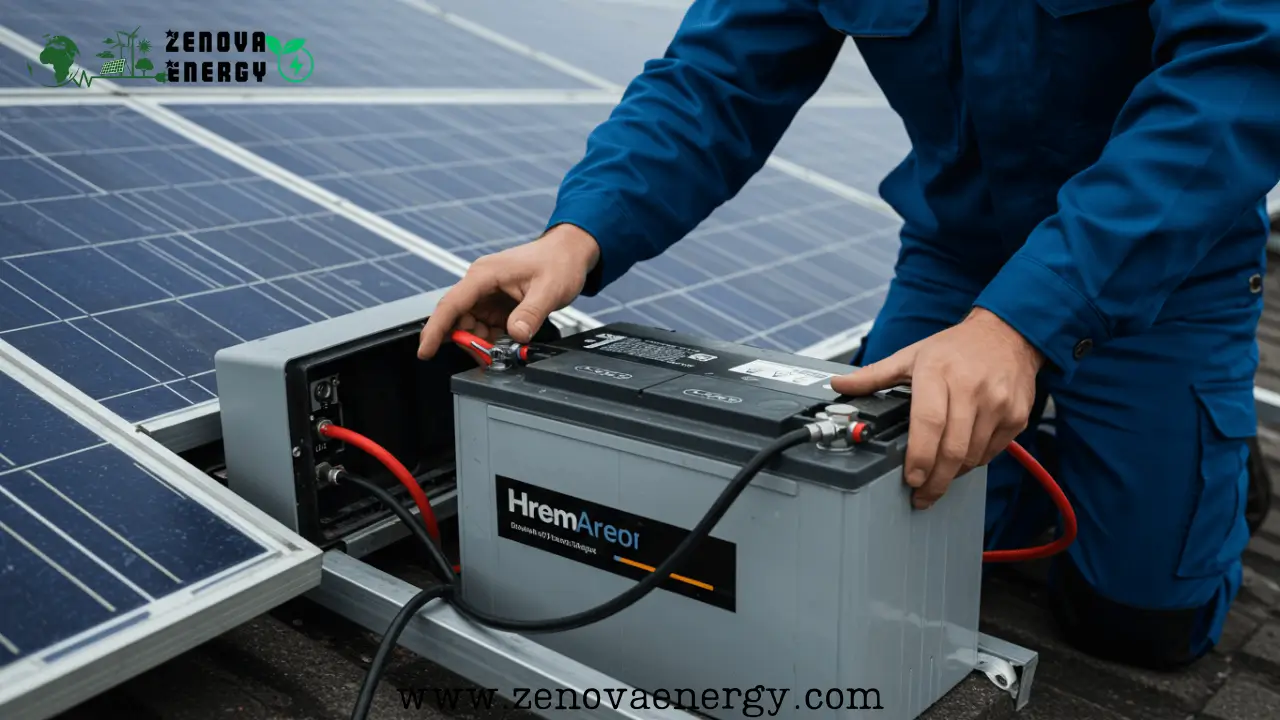Starting a solar battery installation project is a big step towards using renewable energy. Solar batteries store energy from solar panels, letting homeowners use it even when it’s not sunny. This guide will help you understand the process, benefits, types of batteries, tools needed, and safety tips. Knowing these details will help you make smart choices for your energy use.

Table of Contents
Understanding Solar Battery Systems
Solar battery systems are key for managing energy at home and work. They store and use energy from solar panels. Knowing how they work is vital for those interested in solar energy.
What is a Solar Battery?
A solar battery stores energy from solar panels. It’s used when there’s little sunlight, like at night or on cloudy days. Brands like Tesla Powerwall, LG Chem, and Sonnen offer top-notch solar batteries.
Understanding solar batteries helps homeowners choose the right one for their needs.
How Solar Batteries Work
Solar batteries charge when there’s lots of sunlight. They store electricity for later use. This way, they help use energy efficiently and make homes more independent.
Technologies like lithium-ion and lead-acid batteries are used. Lithium-ion is better because it holds more energy and lasts longer.
Benefits of Solar Battery Installation
Installing solar batteries brings many advantages. They can change how you use energy and save money. Knowing these benefits helps homeowners choose sustainable and cost-effective energy solutions.
Energy Independence
One key benefit is energy independence. Solar batteries let homeowners use less grid electricity. This is especially true during power outages or when prices are high.
Homeowners can use stored energy when it’s needed most. This reduces their need for outside electricity sources.
Cost Savings and Incentives
The financial benefits of solar batteries are huge. They save money over time, especially in areas with changing electricity rates. Homeowners can use electricity when it’s cheapest.
Also, there are government incentives. These include tax credits, rebates, and more. They make solar batteries even more affordable.
| Incentive Type | Description | Potential Savings |
|---|---|---|
| Federal Tax Credit | Tax credit for a percentage of installation costs. | Up to 30% |
| State Rebates | Cash rebates provided by state governments. | Varies by state |
| Net Metering | Credit for excess energy sold back to the grid. | Varies; could offset bills significantly |
Types of Solar Batteries
It’s key to know the different solar batteries to store solar energy well. The main two are lithium-ion and lead acid batteries. Each has its own strengths and weaknesses that affect how well they work and last.
Lithium-Ion Batteries
Lithium-ion batteries are popular for their high efficiency and long life. They are small and need little upkeep. You can use more of their energy than other types. Thanks to new tech, they’re a big part of solar systems today.
Lead Acid Batteries
Lead acid batteries have been around for a long time. They’re cheaper upfront, which is good for those watching their budget. But, they don’t last as long and hold less energy than lithium-ion batteries. This affects how well they perform.
Advantages and Disadvantages
Choosing the right solar battery depends on what you need. Lithium-ion batteries are efficient and last long but cost more. Lead acid batteries are cheaper but need more care and hold less energy. Your choice should match your budget and needs.
What Do I Need for Solar Battery Installation?
When you think about solar battery installation, there are key things to know. Understanding these can help make sure your solar battery system works well.
Selecting the Right Battery: Choosing the right battery is critical. It should match your energy needs, budget, and how much you want to store. There are many options out there, and the right one can make a big difference in how well your system works.
Compatibility with Existing Systems: It’s also important that the battery works well with your solar panels and inverter. When all parts work together, you get the best energy storage and use.
Space Considerations: You need to think about where you’ll put the battery. Make sure you have enough space and that it’s easy to get to for maintenance.
Local Regulations: Knowing the local building codes and rules is key. You might need permits before you start. Checking these out early can avoid delays and save time.

Tools and Equipment Required
For a successful solar battery installation, you need the right tools and equipment. These ensure safety, security, and efficiency. Knowing what tools you need can greatly impact your project’s success. Here are the main categories of equipment you’ll need.
Wiring and Cables
Choosing the right wiring and cables is key for safe and effective connections. There are many types and gauges, each for different uses. Make sure to pick wiring that can handle the electrical load to avoid overheating and ensure optimal performance.
Battery Mounting Supplies
You’ll need reliable mounting supplies for solar batteries. Items like brackets, anchors, and supports are crucial. They’re especially important in areas with extreme weather. Proper mounting ensures safety and extends battery life.
Safety Gear
Safety gear is a must for solar battery installation. Personal protective equipment, like gloves, goggles, and hard hats, keeps installers safe. It protects against electrical shocks and other risks in the installation process.
Assessing Your Energy Needs
Before you start with solar battery installation, it’s key to know your energy needs. You need to figure out how much energy you’ll store and how much your solar panels will produce. These steps help you manage your energy well.
Calculating Energy Storage Requirements
Start by figuring out how much energy you use every day. Look at your household or business’s energy use patterns. Think about:
- Daily appliance usage (in watt-hours)
- Seasonal changes in energy use
- Times when you need more energy
After you know your daily energy use, think about how much to store for later use or emergencies. This is important for a steady power supply when you need it most.
Understanding Your Solar Panel Output
Now, look at how much energy your solar panels can make. Several things affect this:
- Where you are and how much sunlight you get
- Panel efficiency, which shows how well they turn sunlight into energy
- How many sunlight hours you get in your area
Knowing these things helps you see how much energy you can store. This is key for meeting your energy needs.

Installation Process Overview
The solar battery installation process has key steps for a successful setup. Knowing what to expect helps prepare you for the journey.
Preparing the Installation Site
Begin by checking the area for the battery. It should be clean, dry, and clear of any blocks. Think about how the installation will look and work, like its distance to solar panels or electrical parts.
Connecting the Solar Battery to the System
With the site ready, connect the solar battery to your solar panel system. Be careful with the wiring and make sure circuit breakers are set right. This step is crucial for safety and performance.
Testing and Commissioning
After connecting, test and start using the system. Check that it works well by looking at performance numbers. You might need to tweak things to get the best out of your solar battery system.
Safety Considerations for Installation
When installing solar batteries, it’s important to focus on safety. Knowing about electrical safety and how to handle batteries is key. This knowledge helps avoid accidents and injuries during the setup.
Understanding Electrical Safety
Electrical safety is a big deal with solar battery systems. It’s important to know the dangers. Always turn off power before starting work. Not doing this can cause serious electrical shocks or fires.
Knowing local electrical rules helps keep the project safe. It guides you on how to do things right.
Proper Handling of Batteries
Handling batteries safely is crucial. Here are some tips:
- Use correct lifting techniques to avoid physical strain or injury.
- Avoid dropping or striking batteries to prevent damage and potential leaks.
- Be aware of the chemical composition of the batteries, as improper handling may lead to spills or leaks, posing environmental hazards.
By following these safety tips, you can make sure your solar battery installation is safe. This leads to a successful project and peace of mind.
| Safety Aspect | Guideline |
|---|---|
| Electrical Safety | Always shut off power sources before starting. |
| Handling Batteries | Use proper lifting techniques. |
| Battery Damage | Avoid dropping or striking batteries. |
| Chemical Awareness | Understand battery chemistry to prevent leaks. |
Conclusion
When setting up solar batteries, getting ready is key. This guide has shown you the different batteries, tools, and safety tips. These steps help make the installation a success.
Knowing what to do and planning well can make your home more energy-efficient. A solar battery system saves money and helps the planet. It uses clean energy more efficiently.
Think about how solar batteries can change your energy use. Whether you do it yourself or get help, solar energy is a big win. It makes your home’s energy use better.
FAQ
What do I need for solar battery installation?
To install a solar battery, first pick the right battery for your energy needs. Make sure it works with your solar panels and inverter. Also, check the space for mounting and local installation rules.
What types of solar batteries are available?
There are mainly two types of solar batteries. Lithium-ion batteries are efficient and last long. Lead acid batteries are cheaper but don’t last as long. Choose based on your needs.
How do I calculate my energy storage needs?
To figure out your energy storage needs, first, calculate your daily energy use. Then, decide how much energy you want stored for later. This will help you pick the right battery size.
What tools and equipment do I need for installation?
You’ll need wiring and cables for connections. Also, battery mounting supplies like brackets and anchors. Don’t forget safety gear like gloves and goggles for a safe setup.
How does a solar battery work?
A solar battery stores energy from solar panels during the day. It then releases that energy at night or when needed. This improves energy use and can lower costs.
What safety considerations should I keep in mind during installation?
Remember to follow electrical safety rules, like turning off power before starting. Also, handle batteries carefully to avoid spills or damage.
Are there incentives for installing solar batteries?
Yes, there are incentives like tax credits and rebates. These can help cover the cost of solar battery installation, making it more affordable.
Can I install a solar battery myself?
Installing a solar battery yourself is possible if you’re skilled. But, it’s often better to hire professionals. They ensure proper installation, safety, and follow local rules.
